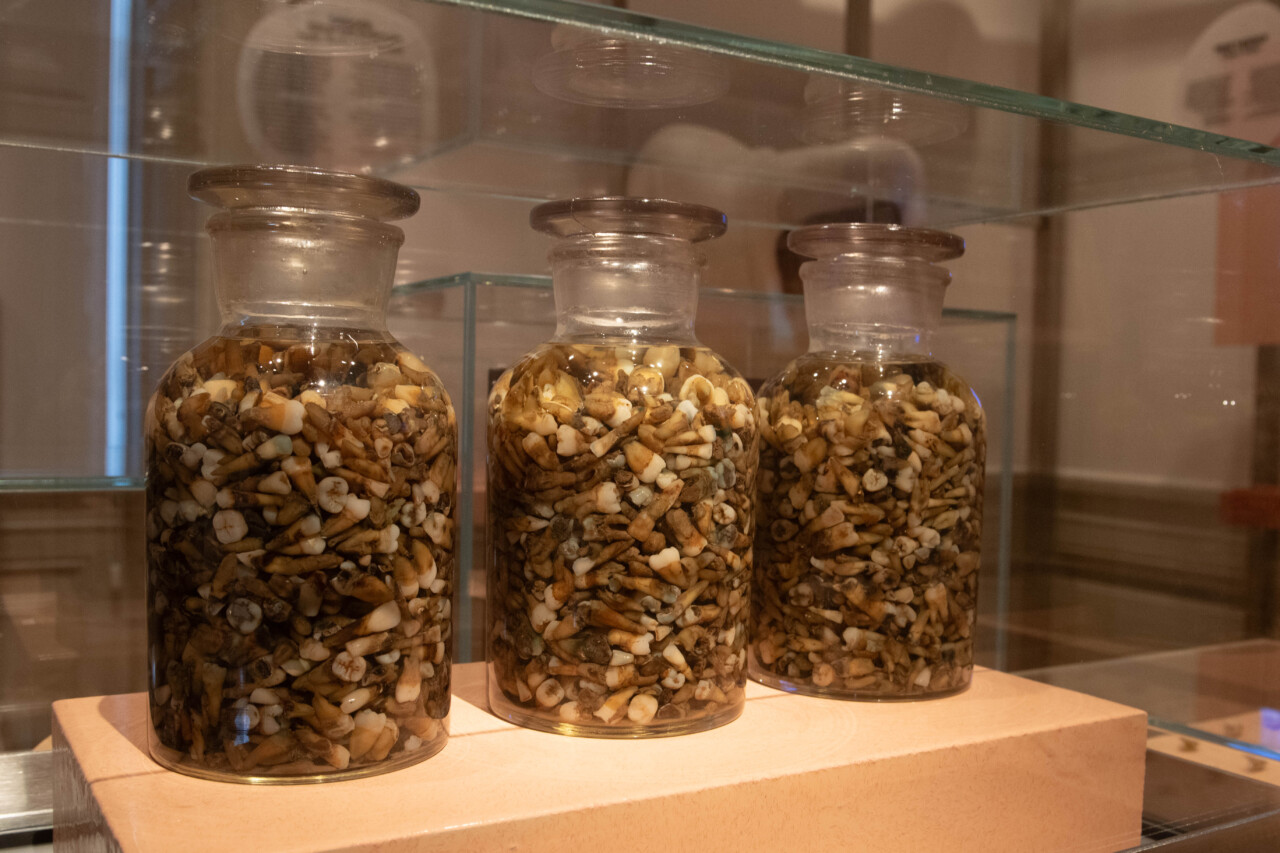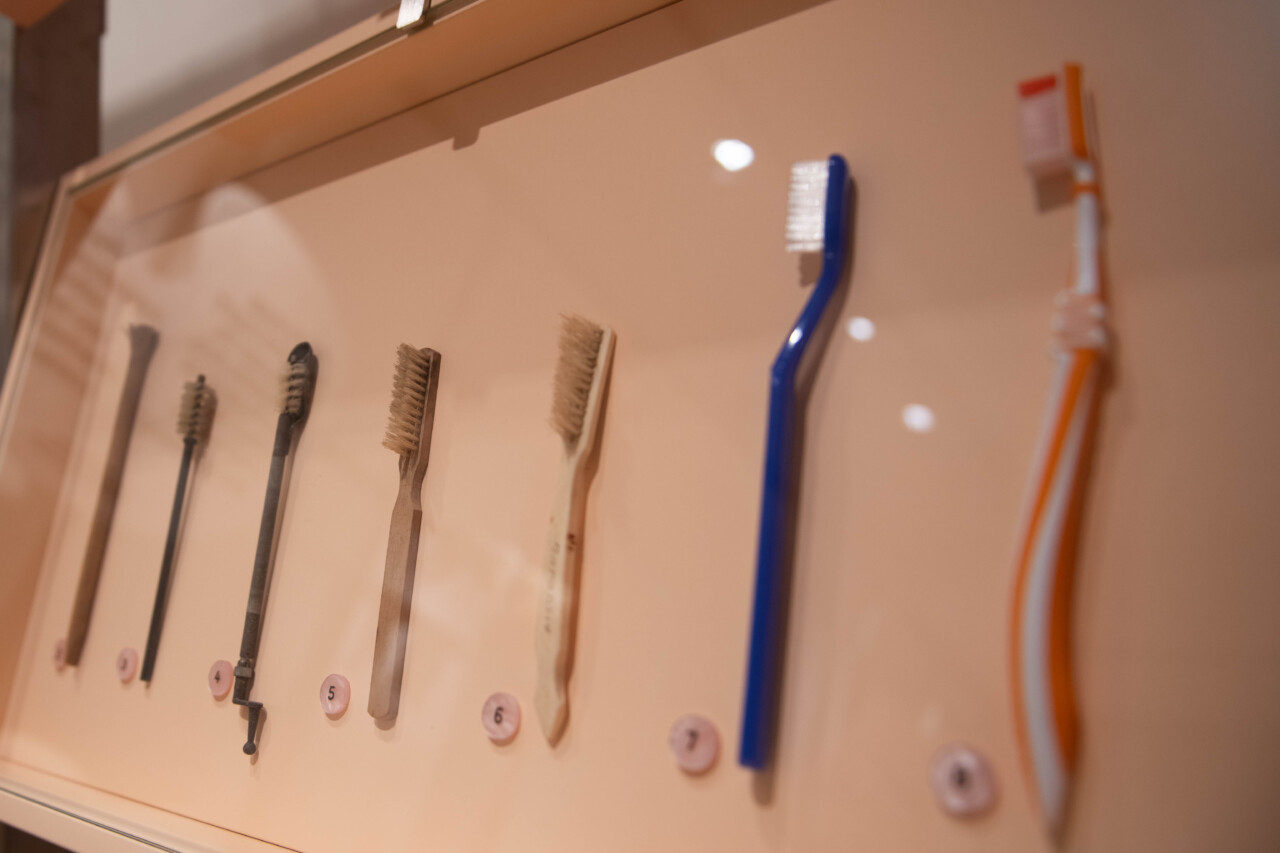Universitetsavisen
Nørregade 10
1165 København K
Tlf: 35 32 28 98 (mon-thurs)
E-mail: uni-avis@adm.ku.dk
—
Culture
Teeth — Medical Museion opens a special exhibition on teeth, revealing how the state of our mouths connects to body, class and identity.
When we meet someone new, we look them in the eye. Or at least, we think we do. In reality, our gaze often slips towards the mouth. A smile, a crooked tooth, a gold crown — or what’s missing. Our teeth matter more than we realise — both for our health and for how the world sees us.
This is the starting point for the Medical Museion’s new special exhibition on teeth, where museum curator Anne Bernth Jensen invites visitors to explore both the inside of the mouth and the wider society.
»Teeth are one of the first things we notice about other people, and one of the last things we want to talk openly about. But they are a crucial part of our health, our self-image, and our social status,« she says.
The museum, which is part of the University of Copenhagen (UCPH), has for decades stored an extensive dental collection in its archives. Now, they’ve opened the drawers, dusted off the acrylic dentures, and put together an exhibition that is both educational and just a little bit macabre.
As Anne Bernth Jensen puts it, the exhibition is about teeth. But just as much, it’s about how we’ve separated teeth from the rest of the body — both medically and symbolically.
»We have hospital departments for the heart, lungs, and liver, but as soon as it comes to teeth, we have to go to a different kind of doctor — and we have to pay for it. It’s as if teeth have been disconnected from the rest of the healthcare system,« she says.
At the museum, visitors can see a heart showing signs of inflammation on the inside — caused by bacteria likely originating from the mouth. The condition is called endocarditis and illustrates how directly the mouth’s environment can affect the rest of the body. The same goes for pneumonia — after all, air passes through the mouth.
»It might sound banal, but everything is connected. Inflammation of the gums can affect your heart. But it’s only now that we’re truly starting to take that connection seriously,« she says.
The exhibition links the common dental problems of the past to the disparities in oral health of the present. A survey from 1896 among Copenhagen schoolchildren showed that 93 per cent had cavities, whereas today it is only a small group of children who account for almost all cases. In Denmark, people now talk of a ‘zero-cavity generation’, but this mainly applies to children who have access to both a toothbrush and a dentist.
»Tooth decay has gone from being a widespread disease to being a stigma. It’s not just about being unlucky — it’s about economic and social conditions,« explains Anne Bernth Jensen.
It’s not just the dentist’s bill that is unequally distributed. When teeth are missing or worn down, it can lead to a feeling of shame. And someone who doesn’t feel like smiling risks being perceived and treated differently by those around them.
»Studies have shown that if you smile, you’re seen as more outgoing and open — and you’re more likely to get the job or be perceived as attractive,« says Anne Bernth Jensen.
»Smile at the world, and it smiles back,« it says on a wall in the exhibition.
»This is why dental issues have such a heavy social impact, when our mouths and teeth are a kind of calling card to the world,« says Anne Bernth Jensen.
Teeth have been something to show off for centuries — not just something to chew with. In this way, they are strong markers of identity.
The museum’s collection includes everything from intricate gold fillings engraved with symbols, to contemporary grillz.
»Even in older dental repairs, you can see aesthetic choices being made. People didn’t just want to be able to chew — they wanted to present themselves in a certain way,« says Anne Bernth Jensen.
It’s a slightly odd idea that our children lose their teeth — and we keep them.
The modern ideal of white, straight teeth has accelerated in tandem with the beauty industry’s takeover of the mouth.
»First it was hair, then nails, then cheekbones. Now it’s teeth that have to be optimised,« she says, adding that the modern ‘Love Island smile’ is no longer reserved for reality shows and the Hollywood elite, but has become mainstream — or at least a common aspiration.
But unlike hair, teeth don’t grow back.
»Once you’ve filed down the enamel, it’s gone. Changes to your teeth are irreversible. There’s no turning back,« says Anne Bernth Jensen.
One of the exhibition’s most eye-catching objects is a pair of teeth allegedly belonging to Johann Friedrich Struensee and Enevold Brandt respectively — two controversial figures in Danish history. Struensee, a German-Danish physician and statesman, had a scandalous affair with the Danish queen, and he and Brandt were executed by beheading in 1772, after which their heads were placed on stakes.
According to the story, the young medical student M. W. Kall pulled a tooth from each of the decapitated heads and kept them as macabre souvenirs.
»It’s a truly fascinating relic, but there’s still much we don’t know. We’ve handed the case over to the history podcast Kongerækken, who will investigate whether the story holds water,« says Anne Bernth Jensen.
Struensee is incidentally the first person in Denmark that we can say used toothpaste with certainty. A requisition from the royal accounts shows that he had a liquid mixed from nine ingredients — including cinnamon, cloves, rose honey, and the exotically named ‘dragon’s blood’, which, in reality, is just a plant.
The exhibition also offers a nostalgic glimpse back into childhood. One video shows how schoolchildren were taught to brush their teeth in the late 1960s, and visitors can also view a copy of a Danish children’s book featuring two tooth trolls, Karius and Baktus, which helped many children remember their oral hygiene.
The Medical Museion has also been in touch with the folkloric ‘tooth fairy’, in the form of a collection of milk teeth from a home in the central Copenhagen district of Nørrebro.
»It’s a slightly odd idea that our children lose their teeth — and we keep them. We wouldn’t do that if they lost a little finger. But teeth somehow hold a special status compared to the rest of the body,« says Anne Bernth Jensen.
The exhibition ‘Teeth’ opens officially on 26 March and will be on display throughout the year. Anne Bernth Jensen hopes not only to enlighten, but also to make people smile.
»I hope people leave here with a smile on their faces — perhaps because they recognised something, perhaps because they learned something, or maybe just because they had a fun experience,« says Anne Bernth Jensen.
And perhaps with renewed motivation to brush more thoroughly:
»Since I started working on this exhibition, I’ve been brushing my teeth a lot more. Because as soon as you start talking about teeth, you stop looking people in the eye — and start looking at their mouths instead,« she says.

